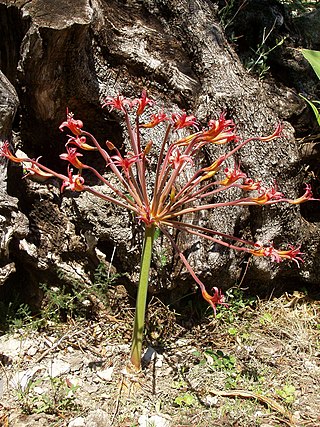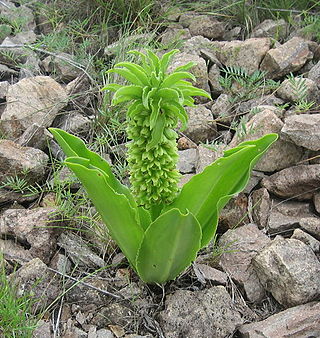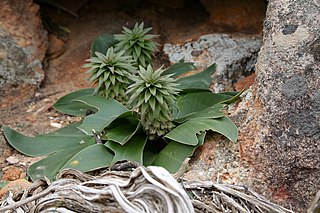
Allium ursinum, known as wild garlic, ramsons, cowleekes, cows's leek, cowleek, buckrams, broad-leaved garlic, wood garlic, bear leek, Eurasian wild garlic or bear's garlic, is a bulbous perennial flowering plant in the amaryllis family Amaryllidaceae. It is native to Europe and Asia, where it grows in moist woodland. It is a wild relative of onion and garlic, all belonging to the same genus, Allium. There are two recognized subspecies: A. ursinum subsp. ursinum and A. ursinum subsp. ucrainicum.

Scilloideae is a subfamily of bulbous plants within the family Asparagaceae. Scilloideae is sometimes treated as a separate family Hyacinthaceae, named after the genus Hyacinthus. Scilloideae or Hyacinthaceae include many familiar garden plants such as Hyacinthus (hyacinths), Hyacinthoides (bluebells), Muscari and Scilla and Puschkinia. Some are important as cut flowers.

Nerine is a genus of flowering plants belonging to the family Amaryllidaceae, subfamily Amaryllidoideae. They are bulbous perennials, some evergreen, associated with rocky and arid habitats. They bear spherical umbels of lily-like flowers in shades from white through pink to crimson. In the case of deciduous species, the flowers may appear on naked stems before the leaves develop. Native to South Africa, there are about 20–30 species in the genus. Though described as lilies, they are not significantly related to the true lilies (Liliaceae), but more closely resemble their relatives, Amaryllis and Lycoris. The genus was established by the Revd. William Herbert in 1820.

Brunsvigia is a genus of African flowering plants in the family Amaryllidaceae, subfamily Amaryllidoideae. It contains about 20 species native to southeastern and southern Africa from Tanzania to the Cape Provinces of South Africa.

Adenium obesum, more commonly known as a desert rose, is a poisonous species of flowering plant belonging to the tribe Nerieae of the subfamily Apocynoideae of the dogbane family, Apocynaceae. It is native to the Sahel regions south of the Sahara, tropical and subtropical eastern and southern Africa and also the Arabian Peninsula. Other names for the flower include Sabi star, kudu, mock azalea, and impala lily. Adenium obesum is a popular houseplant and bonsai in temperate regions.

Scilla section Chionodoxa, known as glory-of-the-snow, is a small group of bulbous perennial flowering plants in the family Asparagaceae, subfamily Scilloideae. Formerly treated as the separate genus Chionodoxa, they are now included in Scilla as a section. The section is endemic to the eastern Mediterranean, specifically Crete, Cyprus and Turkey. The blue, white or pink flowers appear early in the year making them valuable garden ornamentals. The common name of the group is based on the habit of flowering in high alpine zones when the snow melts in spring.

Iris spuria, or blue flag, is a species of the genus Iris, part of the subgenus Limniris and the series Spuriae. It is a rhizomatous perennial plant, from Europe, Asia and Africa. It has purple or lilac flowers, and slender, elongated leaves. It is widely cultivated as an ornamental plant in temperate regions and hybridized for use in the garden. It has several subspecies; Iris spuria subsp. carthaliniae B.Mathew, Iris spuria subsp. demetrii B.Mathew, Iris spuria subsp. maritima (Dykes) P.Fourn. and Iris spuria subsp. musulmanica (Fomin) Takht. It used to have 3 other subspecies, which have now been re-classified as separate species; Iris spuria subsp. halophila, Iris spuria ssp. sogdiana and Iris spuria subsp. notha . It has many common names including 'blue iris', 'spurious iris' and 'bastard iris'.

Scadoxus is a genus of African and Arabian plants in the Amaryllis family, subfamily Amaryllidoideae. The English names blood lily or blood flower are used for some of the species. The genus has close affinities with Haemanthus. Species of Scadoxus are grown as ornamental plants for their brilliantly coloured flowers, either in containers or in the ground in frost-free climates. Although some species have been used in traditional medicine, they contain poisonous alkaloids.

Agapanthus praecox is a popular garden plant around the world, especially in Mediterranean climates. It is native to the Kwa-Zulu Natal and Western Cape provinces of South Africa. Local names include agapant, bloulelie, isicakathi and ubani. Most of the cultivated plants of the genus Agapanthus are hybrids or cultivars of this species. It is divided into three subspecies: subsp.praecox, subsp. orientalis and subsp. minimus.

Cotyledon tomentosa is a species of flowering plant in the family Crassulaceae, native to South Africa. It is a succulent evergreen shrub with large chunky ovate fuzzy green leaves. Its autonymous subspecies is known as the bear's paw because of the prominent "teeth" at the tips of its leaves. It forms large orange bell-shaped flowers in spring. In its native habitat, the Little Karoo region of South Africa, Cotyledons usually grow in rocky quartz fields where they have excellent drainage provided by very porous soil.

Eucomis autumnalis, the autumn pineapple flower, or autumn pineapple lily, is a species of flowering plant in the family Asparagaceae, subfamily Scilloideae, native to Malawi, Zimbabwe and southern Africa. It is a mid to late summer flowering deciduous bulbous perennial. The flower stem reaches about 40 cm (16 in), rising from a basal rosette of wavy-edged leaves. The green, yellow or white flowers are arranged in a spike (raceme), topped by a "head" of green leaflike bracts. It is grown as an ornamental garden plant and can also be used as a cut flower.

Ornamental bulbous plants, often called ornamental bulbs or just bulbs in gardening and horticulture, are herbaceous perennials grown for ornamental purposes, which have underground or near ground storage organs. Botanists distinguish between true bulbs, corms, rhizomes, tubers and tuberous roots, any of which may be termed "bulbs" in horticulture. Bulb species usually lose their upper parts during adverse conditions such as summer drought and heat or winter cold. The bulb's storage organs contain moisture and nutrients that are used to survive these adverse conditions in a dormant state. When conditions become favourable the reserves sustain a new growth cycle. In addition, bulbs permit vegetative or asexual multiplication in these species. Ornamental bulbs are used in parks and gardens and as cut flowers.

Drimia is a genus of African, south European and south Asian flowering plants. In the APG IV classification system, it is placed in the family Asparagaceae, subfamily Scilloideae. When broadly circumscribed, the genus includes a number of other genera previously treated separately, including Litanthus, Rhodocodon, Schizobasis and Urginea.

Eucomis pallidiflora, the giant pineapple lily, is a bulbous species of flowering plant in the family Asparagaceae, subfamily Scilloideae, native to southern Africa. The white to green flowers appear in summer and are arranged in a spike (raceme), topped by a "head" of green leaflike bracts. Some forms reach almost 2 m when in flower. The species is cultivated as an ornamental plant, although it is not hardy in areas where severe frosts occur.

Pseudoprospero is a genus of bulbous flowering plants in the family Asparagaceae, subfamily Scilloideae. The genus has a single species Pseudoprospero firmifolium, which is endemic to South Africa.

Scadoxus multiflorus is a bulbous plant native to most of sub-Saharan Africa from Senegal to Somalia to South Africa. It is also native to Arabian Peninsula and to the Seychelles. It is naturalized in Mexico and in the Chagos Archipelago.It is also found in Indian peninsula. It is grown as an ornamental plant for its brilliantly coloured flowers, either in containers or in the ground in where the climate is suitable. There are three recognized subspecies. Strongly toxic like other Scadoxus species, it has been used as a component of arrow poisons and fishing poisons, as well as in traditional medicine. Common names, some of which are used for other species, include blood lily, ball lily, fireball lily, blood flower, Katherine-wheel, oxtongue lily, poison root and powderpuff lily.
Graham Dugald Duncan(born 1959) is a South African botanist and specialist bulb horticulturalist at the Kirstenbosch National Botanical Garden, Cape Town, South Africa.

Eucomis regia is a species of bulbous flowering plant in the family Asparagaceae, subfamily Scilloideae, native to the Cape Provinces of South Africa. It is sometimes cultivated, but requires protection in a greenhouse in temperate climates.

Tylecodon wallichii is a species of succulent plant in the genus Tylecodon belonging to the family Crassulaceae. The species is named in honour of Nathaniel Wallich, early 19th century Danish plant hunter, botanist and physician.

Tylecodon paniculatus, also known as butter bush, butter tree, butterboom or rooisuikerblom (Afrikaans), is a species of succulent plant in the genus Tylecodon belonging to the family Crassulaceae.























